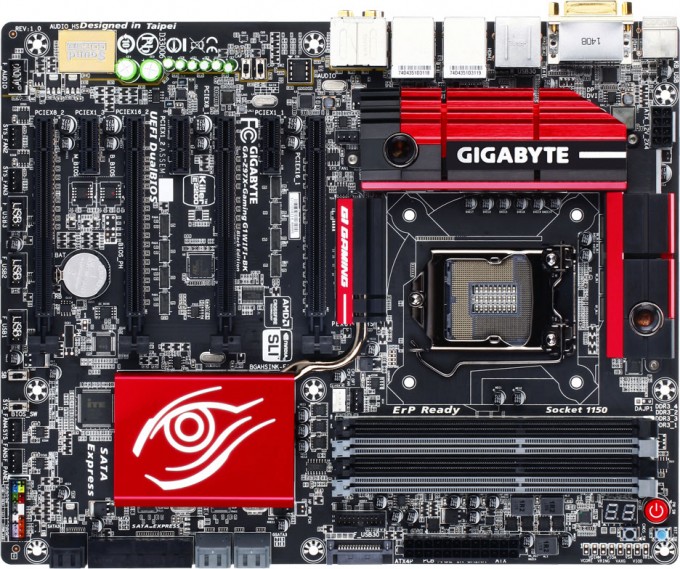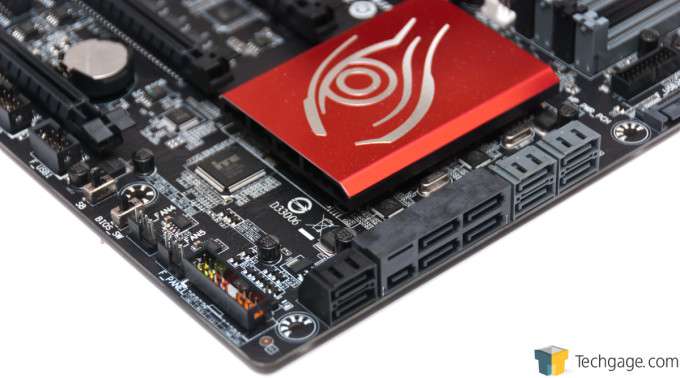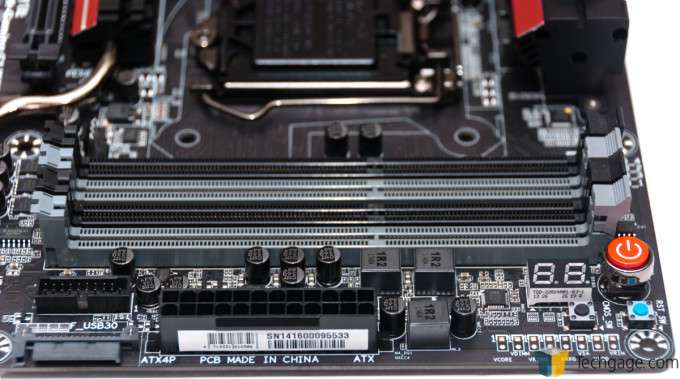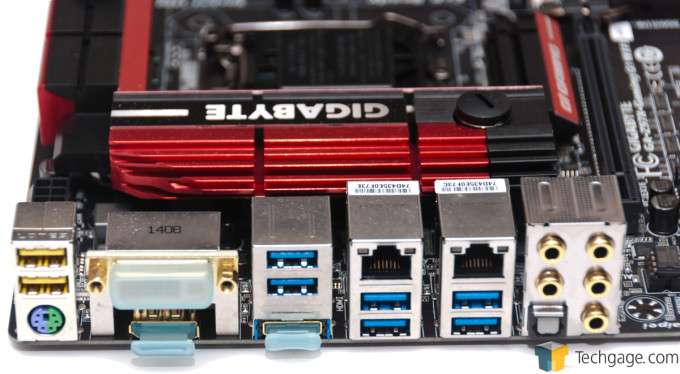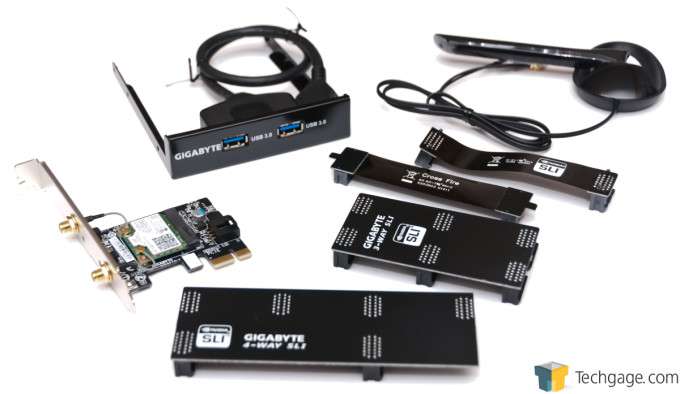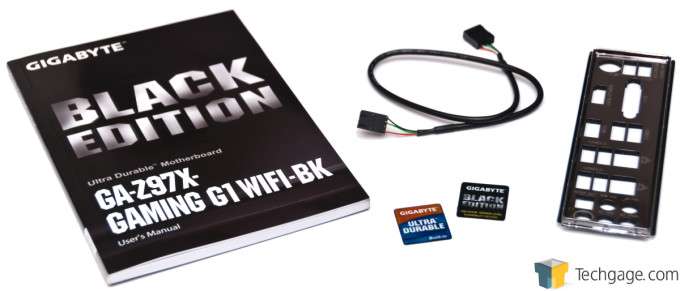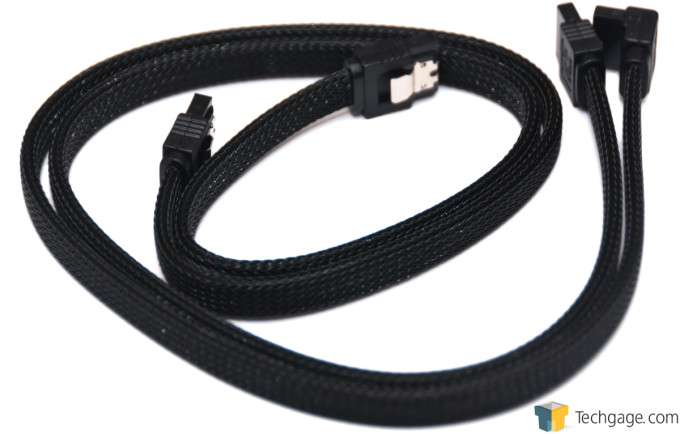- Qualcomm Launches Snapdragon 4 Gen 2 Mobile Platform
- AMD Launches Ryzen PRO 7000 Series Mobile & Desktop Platform
- Intel Launches Sleek Single-Slot Arc Pro A60 Workstation Graphics Card
- NVIDIA Announces Latest Ada Lovelace Additions: GeForce RTX 4060 Ti & RTX 4060
- Maxon Redshift With AMD Radeon GPU Rendering Support Now Available
GIGABYTE Z97X-Gaming G1 WIFI-BK Motherboard Review

Our last two Z97 reviews involved some petite motherboards, so it’s time to go all-out – something GIGABYTE’s Z97X-Gaming G1 WIFI-BK helps us pull off. Its name implies that gamers are the target here, and as you’d expect from its $350 price tag, it’s packed with features. What more reason do you need to read? Come on in.
Page 2 – A Hardware Tour of GIGABYTE Z97X-Gaming G1 WIFI-BK
As a motherboard that costs about $350, you can expect the Z97X-Gaming G1 WIFI-BK to generally offer everything you need, +1. Not many people are going to need ten SATA ports, for example, or all 16 USB ports that can be made available. Heck – even the cooling can be kicked up a notch, thanks to the ability to add the MOSFET area to your water cooling loop. Truly, this is one seriously packed motherboard.
Because motherboards that don’t include many fan headers – or place them in odd locations – annoy me, one of the first things I do after hauling a board out of its box is scan it for those. I was pretty impressed to see that this board includes seven 4-pin fan headers, with two beside the CPU socket and another just above the top-most PCIe slot.
As seen in the stock image above, the other four headers are located at the bottom of the board, a decision that’s hit-or-miss with me. On one hand, I appreciate the clean build that these locations would help with, but I generally appreciate having at least one or two headers near the top-right side of the board – or the top – so that fans mounted to the top can reach it easier. If you also have top-mounted fans, either affixed to the chassis itself or a radiator, you might have to get a little creative to get them plugged-in.
Nonetheless, it’s hard to complain too much when the header locations are hardly poorly placed, especially given the fact that there’s seven of them.
We can see two of these 4-pin fan headers at the bottom right-hand corner of the board, beside a couple of BIOS switches and the chassis connectors. After having dealt with MSI’s truly bizarre chassis connector location with its Z97I Gaming AC, it was a huge relief to see it placed here on GIGABYTE’s board. Also seen here is a SATA Express port along with 10x regular SATA 6Gbps ports.
There’s a lot going on at the top-right corner, with perhaps the most notable feature being the onboard power and reset switches. Also worth noting though are the voltage points right beside the corner screw hole, aiding overclockers who take things more seriously. And on the topic of “serious”, GIGABYTE has included a SATA power connector beside the 24-pin one that it recommends anyone using two or more GPUs take advantage of, as it supplies additional power to the PCIe slots.
For being such a hardcore gamers’ board, the CPU socket area sure does look pretty. Maybe that’s just the hardware geek in me appreciating solid-looking designs. Likewise, the heatsink looks great, and even if you don’t take advantage of the water cooling abilities of it, it should still be effective enough on its own.
On the left-hand bottom corner is the dedicated Creative Sound Core3D audio card which is one of the true highlights of the board. First and foremost, high-quality audio capacitors are implemented here, and should you take things really seriously, you can even swap out the OPAMP. Further, while I’ll never call it an important feature, the audio connectors on the I/O panel are gold-plated. Perhaps more important than that is the fact that the audio card on this board has been strategically-placed to deliver the cleanest audio possible to the I/O panel’s connector.
Notice those small toggles? Those are used to increase the gain in both the left and right channel from 2.5x to 6x, something that could be important for some headphones users.
The back I/O panel includes a total of 8 USB ports, 6 of which are 3.0. Also here are the dual LAN ports, the full complement of audio ports, HDMI, DVI, and DisplayPort video ports, and PS/2. The yellow USB ports at the top are 2.0, and are designed for use with USB-based audio, which GIGABYTE says “provides clean, noise-free power delivery to your Digital-to-Analog Converter“. This might sound like just marketing, but often, your USB bus can become extremely busy and throttle performance; with audio plugged into these ports, your listening experience should never be interupted.
It seems like I’ve been talking about the Z97X-Gaming G1 WIFI-BK’s hardware for a while, but I’m not quite done yet. Next up, the accessories. In this first shot, you can see the included Wi-Fi add-in card and its antenna, along with a front 3.5-inch bay that supplies 2x USB 3.0 ports, and also one of any multi-GPU bridge you’ll need.
Along with the manual and driver DVDs, badges, the I/O panel protector and some front panel cable (I truly have no idea what it’s for; it kind of looks like a floppy connector on one end, while the other is a USB 2.0 header) are also included.
What really stood out to me with this package is that all six of the included SATA cables are sleeved. Is that important? Not at all. Is it nice nonetheless? Damn right it is.
It goes without saying that this board is packed with features and accessories. So let’s get this thing installed, and check out its EFI.
Support our efforts! With ad revenue at an all-time low for written websites, we're relying more than ever on reader support to help us continue putting so much effort into this type of content. You can support us by becoming a Patron, or by using our Amazon shopping affiliate links listed through our articles. Thanks for your support!




